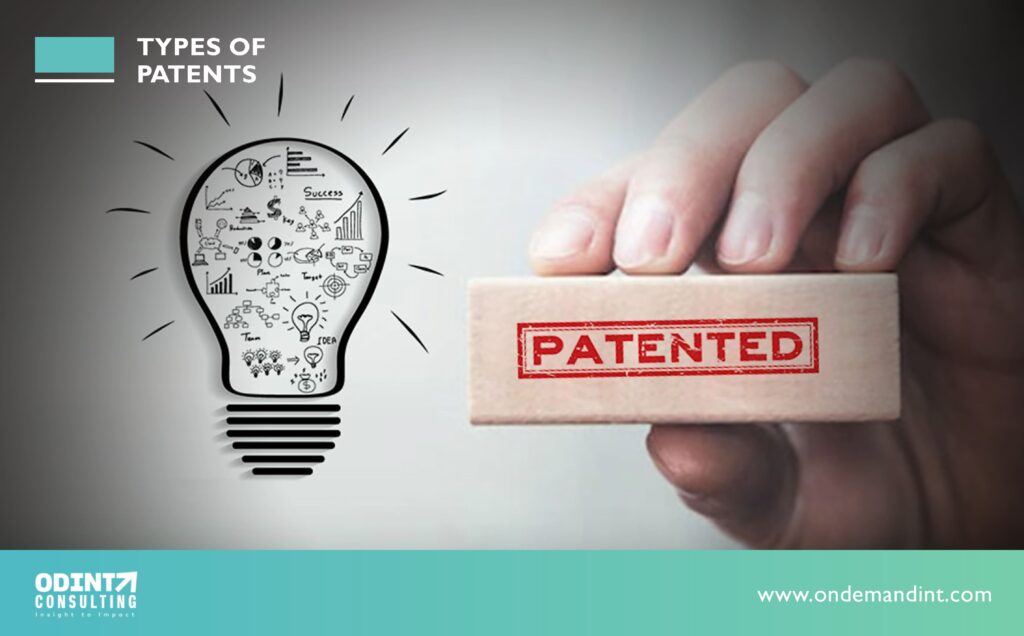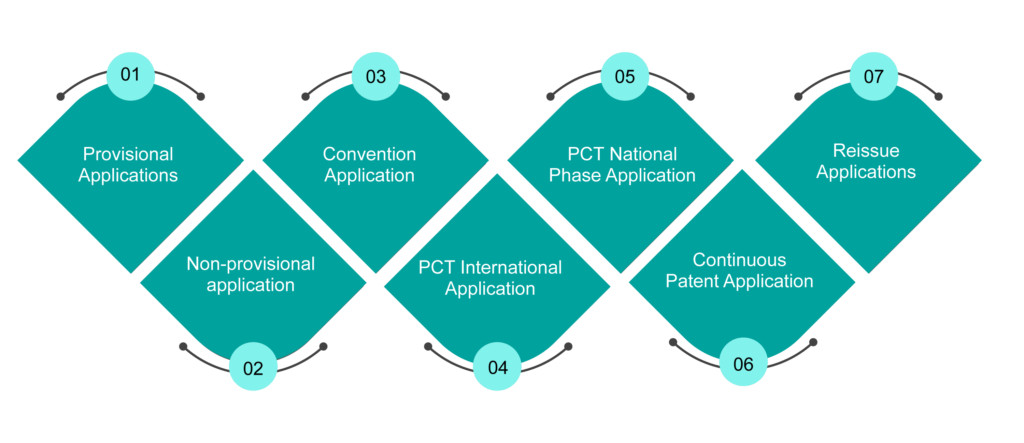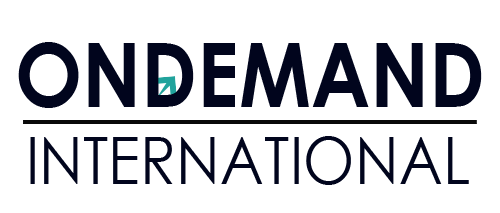Types of Patents
Have you invented a brand new idea/product & worrying about its safety?
Well, it is possible to safeguard your rights over the innovation or creation of your design, product, or art via Patent. A patent is an ownership privilege issued by the government to the person who invented or came up with an item or concept.

Patents are granted by the U.S. Patent and Trademark Office (USPTO) which is the federal agency responsible for regulating patent applications. When the USPTO issues a patent, the patent owner has the sole authority to create, exploit, or market the product or concept.
Patent law is a complex area, it is easy to grasp the basics of different types of patents, that inventors need to be aware of while filing a patent. In this article, the different types of patents & their uses are briefly described.
Why are patents crucial?
Patents are crucial as they grant the creator of a good or concept possession of their intellectual property. This safeguards the person’s ownership of their original invention and prevents anyone from abusing or violating their patent.
There are various additional factors that make patents crucial, such as:
- Protection: Businesses may demonstrate their rightful possession of an item or concept and stop others from exploiting it improperly by patenting their inventions.
- Exclusiveness: For as long as the patent is in effect, the proprietor has the only liberty to make use of or benefit from their creation
- Marketing: When a company secures a patent for an invention, it turns into the sole supplier in that industry segment selling that product.
Several types of Patents
There are three main types of patents: utility patents, design patents & plant patents. Each type of patent comes with its distinct eligibility criteria that safeguard a specific type of idea. Additionally, there is a possibility for a specific patent to be covered by multiple patents.
1. Utility Patents
Utility Patents are granted all over the nation, specifically, those issued in the US estimated for higher than ⅔ of patents grants. Patents are granted for an invention, I.e. new, innovative, or useful, and is non-obvious.
It could include any machine or process, made article or composition of matter or invention that has improved over the prior ones.
There are 3 types of utility:
- General utility:- Rely on the distinct operation,
- Specific utility:- Is the way the invention is utilized to execute its purpose
- Moral utility:- Is the process of making sure that the invention will not be harmful or aids in the wrong usage.
To maintain all patents that are in force, the costs of maintenance fees have to be paid. This became a standard for applications submitted following December 12 the year 1980.
This fee is due over six months following every 3.5, 7.5, and 11.5 years following the date of the grant for the patent. After the six-month window, an additional amount is due when paying the maintenance fee.
There are two important types of Utility patents:
- Provisional Patent:- This patent allows you the time to prepare your normal patent. When you get the temporary patent, you can compare your innovation to ” patent pending.” You will have 12 months to make a regular application for a patent (RPA) following the receipt of an interim patent. The price for obtaining a temporary patent may differ greatly. Small businesses could submit their provisional application for about $100.
- Regular Utility:-The actual patent that will remain in force for 20 years, if you are granted a regular utility patent. Your invention is no longer patent-pending to being patented. After the patent expires you may pay maintenance charges to renew it.
2. Design Patents
A Design patent is a type of patent granted to layout or structures. It’s not restricted to and can include tables, chairs, shoe machines, and fonts that have distinct computer icons as well as others.
To be granted a patent for the design, the design must be artistic or ornamental, & must not be practical. Similar to a typical utility patent, upon granting or granting a design patent, the creator is granted the sole right to prevent others from creating or selling, and even importing the design.
In contrast to utility patents, design patents don’t need maintenance fees. According to the most recent trends, numerous companies have filed design patents to protect inventions that involve user interfaces that include curving or designed edges, or the shapes of user interfaces.
In legal terms, a design is defined as the ornamentation on the surface of an object. This includes the form or the configuration of the object. The creators must ensure that the design is not separable from the object to get the protection of a design patent.
Design patents only cover the aesthetics of the object, whereas utility patent applications should be filed when an inventor is seeking to protect the structural or functional aspects of the object.
3. Plant Patents
Plants Patents can be granted to patent inventions or discoveries, or asexual reproductions of any unique and novel species of plants. Asexual reproduction is when the plant reproduces by cutting or grafting the plant or using alternative methods other than reproducing the seed.
Reproduction in a plant is portrayed as proof of sexual reproduction. It could be the result of the generation of hybrid varieties or mutations as well as newly discovered seedlings cultivating various kinds of plants. The patent for plants focuses more on traditional horticulture.
It ensures the rights of the inventor by preventing others from creating the plant type or profiting profits from the plant for approximately 20 years from the time that the patent is filed & there are no maintenance costs.
Various types of Patents Application

Patent applications are an application that is filed to seek the granting of a patent, typically for an idea of invention discovered and later presented in the application.
An appropriate application will consist of an explanation of the idea and the required forms and the cost for the application. Each patent application serves an exclusive purpose, even though there can be different types of patents application.
Different Types of Patents Applications are:
Provisional Applications
An application that is provisional is one type of application that doesn’t need to be written in a specific format or need to contain all the details.
The application is usually filed in cases where the invention has not been completed or is under investigation. The filing is done to obtain priority date benefits and to stop others from filing patent applications for the same invention.
Non-provisional application
A non-provisional request for a patent submitted to the Patent Office without acknowledging any primacy over the patent application filed in any other country or getting things into account any connection of any similar patent which may be in the procedure at any office is known as an ordinary application or non-provisional application.
Convention Application
A convention application is documented to assert the preference date of an identical innovation and which application it is documented in any one of those countries that is convention.
This allows the inventor to claim priority in the country of the convention for an invention that has been filed in any other country.
PCT International Application
A PCT application is an application for international use that helps investors obtain a patent for several countries with the same filing, but the application does not grant the possibility of grating the international trademark.
It is governed through the Patent Cooperation Treaty (PCT) and is valid by all countries that sign the treaty.
PCT National Phase Application
The idea is that inventors need to make a national phase filing within every country in which they need protection by the filing of a patent.
The deadline for applying is within 31 months of the date of implication or the date of registering internationally or rapidly, whichever comes first. The deadline may be extended or extended via National Laws by each partner country.
Continuous Patent Application
this is a patent application that acknowledges a previously granted patent. This could include an extension, divisional or continuation-in-part applications.
The continuation allows only amendments to the claim and continuation-in-part applications allow for an amendment to the claim and descriptions. Both are typically accessible within the US only.
Reissue Applications
If the inventor or applicant surrenders their patent and files a fresh application to fix the flaw, like when the patent granted does not fully cover the invention disclosed, a patent application is issued.
This is done by filing the patent application again with a larger claim scope (no additional claim expansion is permitted at present) and obtaining complete coverage.
Few Common Mistakes to avoid while Filing Patent
Beware of the most frequent mistakes that are made when dealing with different kinds of patents, like the following:
- False patent – Do not file the patent until you’re confident, that it’s the correct one. Contact a patent lawyer for assistance if you’re unclear.
- Many claims – The patent applicant can only submit a single claim in a patent application. You may get multiple patents for an invention, however, each patent should cover only one aspect of the invention.
- Broadness– Do not file for any kind of patent if your descriptions are too broad. You could be a target for patent Trolls those who purchase patents from other firms and bring lawsuits against other businesses over infringing.
- Waiting to file– If you have an item to sell and the USPTO provides you with a year to apply for a provisional or non-provisional patent. If you do not file then you will not be capable of receiving a patent for your innovation.
- The public uses– The USPTO also sets limitations for public use. If you exhibit your invention, you are allowed one year to submit a patent.
- Bad application– Although your application is valid, however, the USPTO may reject it because it’s not backed by the proper details. Always consult an agent or lawyer for patents to ensure you’ve submitted an accurate application.
Conclusion
A patent is an exclusive right that is provided to the proprietor of an invention or product for a specific period of time and prevents others from producing, exploiting, or trading that invention or product. Patents also allow the inventor to pursue legal action against those who reproduce or use their inventions without your consent. But, in order to file for the correct patent, you must be aware of the several types of patents available in the US. In addition, you need to understand the type of application you must submit.
The professionals at Odint Consulting can help you complete your patent application accurately and submit it to the USPTO. Contact our specialists if you have any questions about the different types of patents or how to apply for them.
FAQ’s
Giving patients an end date will authorize competitors to maintain the cost competitive and allow modifications to the idea. Some firms need to keep up with the IP that they utilize to develop products.
A U.S. utility patent has a period of 20 years from its earlier effective, non-provisional U.S. filing date
The USPTO will assist inventors to secure the intellectual properties of their inventions. To do so, it needs as much data as feasible.
The USPTO receives a lot of applications every month. Examiners only have time to review as many within a certain period, which results in an unending backlog. If you file earlier, you’ll be able to obtain your patent more quicker.
If you possess a small-sized firm, you may want to put off patenting the idea. Small patents for business will help safeguard your brand’s reputation and increase the market, yet they could cost you money.

